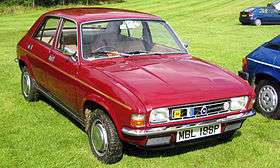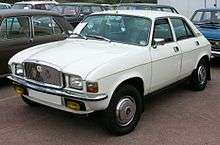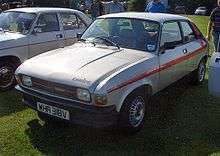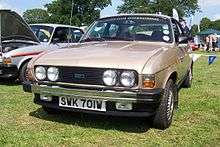Austin Allegro
| Austin Allegro | |
|---|---|
 | |
| Overview | |
| Manufacturer | Austin (British Leyland) |
| Also called |
Vanden Plas 1500[1] Vanden Plas 1.5[1] Vanden Plas 1.7[1] Innocenti Regent |
| Production | 1973–1982 |
| Assembly |
Longbridge Seneffe Milan |
| Body and chassis | |
| Class | Compact car / Small family car (C) |
| Body style |
2-door saloon 3-door estate 4-door saloon |
| Layout | FF layout |
| Related | Innocenti Regent |
| Powertrain | |
| Engine |
1.0 L A-Series I4 1.1 L A-Series I4 1.3 L A-Series I4 1.5 L E-Series I4 1.7 L E-Series I4 |
| Dimensions | |
| Wheelbase | 2,438 mm (96 in) |
| Length | 3,861 mm (152 in) |
| Width | 1,600 mm (63 in) |
| Height | 1,397 mm (55 in) |
| Kerb weight | 869 kg (1,915 lb) (approx) |
| Chronology | |
| Predecessor | Austin 1100/1300 |
| Successor | Austin Metro |
The Austin Allegro is a small family car that was manufactured by Austin from 1973 until 1982. The same vehicle was built in Italy by Innocenti between 1974 and 1975 and sold as the Innocenti Regent. In total, 642,350 Austin Allegros were produced during its ten-year production life, most of which were sold on the home market.
Design
The Allegro was designed as the replacement for the Austin 1100 and 1300 models, designed by Sir Alec Issigonis. As with the Morris Marina, the car can be seen with hindsight as symptomatic of the enormous difficulties facing British Leyland during that period. The key factor that British Leyland can now be seen to have missed is that a much more useful and popular form of car, the hatchback, was emerging in Europe, with designs such as the Autobianchi A112, Renault 16, and Volkswagen Golf. This configuration would go on to dominate the market for small family cars in the space of a few years. British Leyland stuck to the more traditional and less versatile booted design when they launched the Allegro. This was because of internal company politics: it had been decided that the Austin Maxi should have a hatchback as its unique selling point, and that no other car in the company's line-up was allowed one. This decision hamstrung both the Allegro and the Princess, both designs naturally suited to a hatchback yet not given one.

The Allegro used front-wheel drive, using the familiar A-Series engine with a sump-mounted transmission. The higher-specification models used the SOHC E-Series engine (from the Maxi), in 1500 cc and 1750 cc displacements. The two-box saloon bodyshell was suspended using the new Hydragas system (derived from the previous Hydrolastic system used on the 1100/1300).

Stylistically, it went against the sharp-edged styling cues that were becoming fashionable (largely led by Italian designer Giorgetto Giugiaro), and featured rounded panel work. The original styling proposal, by Harris Mann, had the same sleek, wedge-like shape of the Princess, but because British Leyland management, keen to control costs, wanted to install the existing E-Series engine and bulky heating system from the Marina, it became impossible to incorporate the low bonnet line as envisaged: the bodyshell began to look more and more bloated and tubby. This was acceptable to BL, however, which according to Jeff Daniels' book British Leyland, The Truth About The Cars, published in 1980, wanted to follow the Citroën approach of combining advanced technology with styling that eschewed mainstream trends in order to create long-lasting "timeless" models. Its unfashionable shape was thus not a problem to them. The final car bore little resemblance to Mann's original concept that had originally been conceived as an 1100/1300 re-skin. This, as well as British Leyland's faith in it as a model that would help turn the company around, led to it earning the early nickname of the "flying pig".
With the Allegro, the makers avoided the full extent of badge engineering that had defined the marketing of its predecessor, which was mostly sold as an Austin although it was sold under almost all of the brands which BMC/BL owned, but they nevertheless introduced in September 1974[2] an upmarket Allegro, branded as the Vanden Plas 1500/automatic. This featured a prominent grille at the front and an interior enhanced by a range of modifications designed to attract traditionally inclined customers, including: special seats upholstered in real leather, with reclining backrests; deep-pile carpets; extra sound insulation; a new instrument panel in walnut; walnut folding tables for the rear passengers; nylon headlining; and for the luggage, a fully trimmed boot/trunk. In 1974, a time when the UK starting price for the Austin Allegro was given as £1159, BLMC were quoting, at launch, a list price of £1951 for the Vanden Plas 1500.[2] The Allegro name was not used on this version.

Early Allegro models featured a "quartic" steering wheel, which was rectangular with rounded sides. This was touted as allowing extra room between the base of the steering wheel and the driver's legs. The quartic wheel did not take off, and was dropped in 1974 when the SS model was replaced by the HL. The VP 1500 was never introduced with one, despite it being featured in the owner's manual. Despite this feature only having appeared on certain models for a limited time, the Allegro has always been associated with the criticism that it "had a square steering wheel".
In April 1975 a 3-door estate car version was added to the range. Allegros were now coming off the production line with the same conventional steering wheel as the Morris Marina,[3] although the company waited till early June 1975 to announce, rather quietly, the demise of the Allegro's quartic steering wheel, presumably to give time for older cars to emerge from the sales and distribution network. Similar to the 2-door saloon, the Allegro estate had a coachline and also featured a rear wash-wipe. The spare wheel was housed under the rear load floor area. It was only in production for about 100 days before the arrival of the Series 2 model, making Series I Allegro estate rarer than most other models in the range.
There was a similar situation in New Zealand, where the New Zealand Motor Corporation, which at the time had CKD kit assembly plants in Newmarket and Panmure, Auckland, and Petone, Wellington, began Allegro assembly in 1975 – with the circular steering wheel. Only a few hundred 'Mark Ones' – among the first locally-built car models to have a factory-fitted heated rear window – were built before the 'Mark Two' was launched. Most Allegros sold in New Zealand had the 1300 cc A-series OHV engine and four-speed manual gearbox. Later, the 1.5 litre OHC engine was offered with a four-speed automatic 'box, but this was eventually dropped. NZMC, moving away from UK-sourced cars to models from its Honda franchise (it began Civic assembly in 1976, with the Accord following in 1978), later rationalised Allegro output to offer just two paint colours, metallic brown or solid dark blue, with a cream vinyl roof and brown interior trim. One batch of 48 'Mark Three' CKD kits was shipped from England after NZMC had decided to drop the Allegro in 1980, and these were assembled and sold – also in brown or cream; these rare cars have four round headlights rather than two square units, and different tail lights, plus a restyled dashboard.
Dimensions

- Overall length: 3,861 mm (152 in)
- Overall width: 1,600 mm (63 in)
- Height: 1,397 mm (55 in)
- Wheelbase: 2,438 mm (96 in)
- Track: 1,346 mm (53 in)
- Weight: 1,915 lb (869 kg)
- Tyre size: 145 x 13 (155 x 13 on 1750 and Sport)
Allegro 2 (1975–79)
Launched in time for the London Motor Show in October 1975, the Allegro 2 had the same bodyshells but featured a new grille, reversing lights on most models and some interior changes to increase rear seat room. The Estate gained a new coachline running over the wing top lip and window edges. Changes were also made to the suspension, braking, engine mounts and drive shafts.
Since the original Allegro had been launched more than two years earlier, several of BL's key rivals in Europe had launched new competitors - these included the MK2 Ford Escort, as well as the ground breaking and highly acclaimed Volkswagen Golf. A popular Japanese rival, the 120Y generation of the Datsun Sunny, had also been launched in Europe soon after the Allegro. General Motors had also introduced a slightly smaller car, the Vauxhall Chevette, which majored on practicality to rival larger vehicles due to its hatchback body.
At the end of 1976 British Leyland confirmed that they were holding exploratory talks with trades union representatives concerning the possible transfer of Allegro production from Longbridge to the company's plant at Seneffe in Belgium.[4] The Belgian plant was already assembling the cars for continental European markets using CKD kits shipped from the UK.[4] The stated objective of the transfer was to free up capacity at Longbridge for the manufacture of the forthcoming ADO88 Mini replacement. In the event, the ADO88 project was abandoned and the eventual Mini replacement, the less ambitiously engineered Austin Metro, did not reach the market place for another four years. Whether for reasons of politics or of customer demand or of cost, at a time of rapid currency realignment, Allegros for the UK market continued to be manufactured in the UK; the Belgian plant was closed in the early 1980s, by which time Allegro demand in continental Europe had faltered and BLMC's Austin-Morris division clearly had more production capacity than product demand.
Some models of Allegro 2 made for non-UK markets were equipped with four round headlights, rather than the usual two rectangular units.
Only weeks before the launch of the Allegro 3, 1979 saw the release of the 1.7l Allegro Equipe; a two-door sport style model in silver with red and orange hockey stick-shaped cheatlines and alloy wheels manufactured by GKN. The car was unveiled to the press at Sherburn-in-Elmet in North Yorkshire without the distinctive trim.[5] The Equipe was intended to compete with the Golf GT and the Escort RS; by now though the aging Allegro with its lack of hatchback and dated styling struggled to compete against these offerings and sales were poor.
Allegro 3 (1979–82)



The Allegro 3, introduced at the end of 1979, used the "A-Plus" version of the 1.0 litre A-Series engine (developed for the forthcoming new Metro), and featured some cosmetic alterations in an attempt to keep the momentum going, but by then the Allegro was outdated, competing against the relatively high-tech Ford Escort Mark III and Vauxhall Astra, both launched within a year of the Allegro's facelift. The cosmetic alterations were fairly minimal; the Allegro 3 gained a new grill with the revised Leyland badge; it carried the 'Allegro 3' name, bore a larger bumper and gained additional side indicators. The interior was modernised with new components such as a new round four spoke steering wheel.
British Leyland entered the small hatchback market – pioneered during the 1970s by the likes of the Renault 5 and Volkswagen Polo – with its Metro which was launched in October 1980. The Metro would be built at the Longbridge plant, which had just been expanded to provide adequate production capacity for the new car. But with BL hoping to sell more than 100,000 Metros a year in Britain alone, more capacity for production was needed and production of the Allegro and the Mini were pruned back as a result.
After 1980, it failed to feature in the top 10 best selling new cars in Britain, barely a decade since its predecessor had been Britain's most popular new car, though this fall in sales was compensated by the large sales figures achieved by the smaller Metro, as well as the fact that the slightly larger Triumph Acclaim was among Britain's top 10 selling cars by 1982.
The Vanden Plas models were rebranded as the 1.5 and the 1.7,[6] the 1.5 having a twin carburettor 1500 cc engine and a manual gearbox, while the 1.7 had a single carburettor 1750cc engine and an automatic gearbox.
Some models of Allegro 3 (the early HL and later HLS models) were equipped with four round headlights, rather than the more usual two rectangular ones.
Allegro production, which had lasted for nearly a decade, finally finished in March 1982. Its successor, the Austin Maestro, went into production in December 1982 and was officially launched on 1 March 1983.[7] The backlog of unsold Allegro 3 models remained sufficient to stock dealerships into 1983 until after the Maestro had launched.[8]
Reputation
Upon its launch the Allegro was not particularly badly received by critics, but the gearchange drew criticism.[9] and the "quartic" steering wheel "comprising four curves joined together by four straight lines, similar to the shape of a Television screen", fitted partly in order to compensate for the shortage of space between the driver and the rather low steering column, was widely derided by motoring journalists, especially when faced with the manufacturer's insistence that this curious steering wheel design was "avant garde and high-tec".[10] In other respects the car was somewhat underdeveloped, and a number of design flaws plagued the early models, earning it the nickname of the 'All Aggro', which intensified over the next few years as well publicised stories about its build quality and reliability emerged. Most of these were fixed in the Allegro 2 edition of the car, launched in 1975, by which time a slightly small round steering wheel had quietly been substituted for the "quartic" original. although the car never quite managed to shake off its initial reputation.
In spite of all of this bad press, the Allegro was still a very popular car. As late as 1979, six years after its launch, it was the fifth-best-selling new car in Britain.
Sales in its final years were disappointing, and by 1981 it had fallen out of the top ten as more buyers were choosing two newer BL products: the similar-sized and more viable Triumph Acclaim, and the smaller Austin Metro.
In his book Crap Cars, writer Richard Porter says "the only bit of the Allegro they got even vaguely right was the rust-proofing". The Allegro was placed second worst in his list, beaten only by the VW Beetle.[11] Despite this, the Allegro picked up a reputation for rust problems during its life. This was probably due to association with many other cars of the period (both from BL and other manufacturers) which had poor rust proofing. An early edition of What Car? ran a feature on the then new Allegro, including an interview with staff at a BL dealership, who were asked if any problems occurred with the car in service. They replied that the car suffered from rust problems to its rear subframe. However, the staff thought they were being asked about the 1100/1300 car, which had been out of production for five years. Nonetheless, the magazine went on to report on the Allegro's non-existent rust problems, creating a serious image problem.
The poor reputation of the car and the inefficient production and management techniques in British Leyland at the time at which it was produced have meant that the Austin Allegro has become associated with waste, inefficiency and poor quality. In Clarkson's Car Years Jeremy Clarkson compares the Austin Allegro to the Morris Marina. He concludes the Allegro was a better (less bad) car than the Marina, because the Allegro was a horrible car in a more original way than the Marina. In 2007, Sir Digby Jones, in criticising the inefficiencies of the Learning and Skills Council, said, "It is what I call 'the British Leyland model' – you put a lot of money in at the top, and an Austin Allegro comes out at the bottom".[12]
Quality problems concerning the Allegro led to British Leyland making the training video 'the Quality Connection' outlining both superficial and dangerous issues that can arise from a lack of care and attention.[8]
Legacy
The Allegro is generally considered amongst the most disreputable British Leyland models; some credibility was restored with its replacement the Maestro which was tipped as an adequate competitor to the Ford Escort, Vauxhall Astra and Volkswagen Golf. By the time of the Maestro's launch, a string of poor quality models throughout the 1970s had damaged the reputation of British Leyland and the Austin brand with the Maestro selling fewer models over a greater number of years (605,000 over 12 years to 642,000 Allegros over 8 years). Beginning in 1987 the Austin name was phased out in favour of the Rover name which hadn't been tainted with some of the poorer products that had dented the reputation of the Austin brand.
In February 2006 it was reported that more than 1,000 Allegros sold in Britain were still registered with the DVLA,[13] a better survival rate than the more popular Morris Marina, most of which were dismantled for parts that were interchangeable with other British Leyland cars such as the MGB, Mini and Morris Minor. However, that figure had fallen to just 195 cars by February 2016 (excluding cars which were SORN).[14]
Engines
- 1973–75: 1,098 cc (67.0 cu in) A-Series Straight-4, 49 hp (37 kW; 50 PS) at 5250 rpm and 60 lb·ft (81 N·m; 8 kg·m) at 2450 rpm
- 1975–80: 1,098 cc (67.0 cu in) A-Series Straight-4, 45 hp (34 kW; 46 PS) at 5250 rpm and 55 lb·ft (75 N·m; 8 kg·m) at 2900 rpm
- 1973–80: 1,275 cc (77.8 cu in) A-Series Straight-4, 59 hp (44 kW; 60 PS) at 5300 rpm and 69 lb·ft (94 N·m; 10 kg·m) at 3000 rpm
- 1980–82: 998 cc (60.9 cu in) A-Plus Straight-4, 44 hp (33 kW; 45 PS) at 5250 rpm and 52 lb·ft (71 N·m; 7 kg·m) at 3000 rpm
- 1980–82: 1,275 cc (77.8 cu in) A-Plus Straight-4, 62 hp (46 kW; 63 PS) at 5600 rpm and 72 lb·ft (98 N·m; 10 kg·m) at 3200 rpm
- 1973–82: 1,485 cc (90.6 cu in) E-Series Straight-4, 69 hp (51 kW; 70 PS) at 5600 rpm and 83 lb·ft (113 N·m; 11 kg·m) at 3200 rpm
- 1973–82: 1,748 cc (106.7 cu in) E-Series Straight-4, 76 hp (57 kW; 77 PS) at 5000 rpm and 104 lb·ft (141 N·m; 14 kg·m) at 3100 rpm
- 1974–?: 1,748 cc (106.7 cu in) E-Series twin-carburetted Straight-4, 90 hp (67 kW; 91 PS) at 5000 rpm and 104 lb·ft (141 N·m; 14 kg·m) at 3100 rpm
In popular culture
- In 2006 television series Life on Mars, the marked police cars are Austin Allegros.
- Austin Allegro is referenced in Mike Bassett England Manager by Lonnie Urquhart. "He's got all the pace of an Austin Allegro, and I'm not talking Vanden Plas."
- The car is featured prominently in A Gun For George, the movie frequently refers to features of the Austin Allegro such as the "quartic" steering wheel and its hydragas suspension system.
Advertising
When launched in 1973, the Allegro was sold under the slogan 'the new driving force from Austin'. In 1979 the Equipe and the Allegro 3 were sold under slogans based around the word 'vroom'.
References
- 1 2 3 The Vanden Plas Owners Club Retrieved on 18 February 2013
- 1 2 "Vanden Plas 1500: A new luxury model from British Leyland based on the 1,485 cc Austin Allegro 1500 with special trimming and finish by Vanden Plas". Autocar. Vol. 141 (nbr4065). 21 September 1974. pp. 26–28.
- ↑ "News: Allegros – quartic wheel abandoned". Autocar. Vol. 141 (nbr 4100). 7 June 1975. p. 25.
- 1 2 "News: Allegro for Belgium?". Autocar. Vol. 145 (nbr 4178). 4 December 1976. p. 26.
- ↑ "Concepts and prototypes : Allegro Equipe". AR Online. Retrieved 2016-05-10.
- ↑ Vanden Plas 1.5 & 1.7 Series 3 1979–80 UK market sales brochure
- ↑ "The best of the British car industry". AROnline. Retrieved 8 April 2012.
- 1 2 "The Austin Allegro at 40". The Telegraph. 2013-05-25. Retrieved 2016-05-10.
- ↑ Buckley, Martin (7 December 2015). "Austin Allegro: how the worst car of all time came to be made". telegraph.co.uk. Telegraph Media Group Limited. Retrieved 27 July 2016.
- ↑ Keith Adams (30 November 2015). "The cars : Austin Allegro development history". Retrieved 27 July 2016.
- ↑ "The crappest car in Britain – named and shamed in Crap Cars" (Press release). BBC. 13 October 2004. Archived from the original on 29 March 2007. Retrieved 25 April 2007.
- ↑ "Can we fix the skills shortage?". BBC. 20 February 2007. Retrieved 7 March 2008.
- ↑ The Observer newspaper Archived 3 February 2008 at the Wayback Machine.
- ↑
- Adams, Keith. "The Unofficial Austin Rover Web Resource".
External links
| Wikimedia Commons has media related to Austin Allegro. |
| Wikimedia Commons has media related to Vanden Plas 1500/1.5/1.7. |
